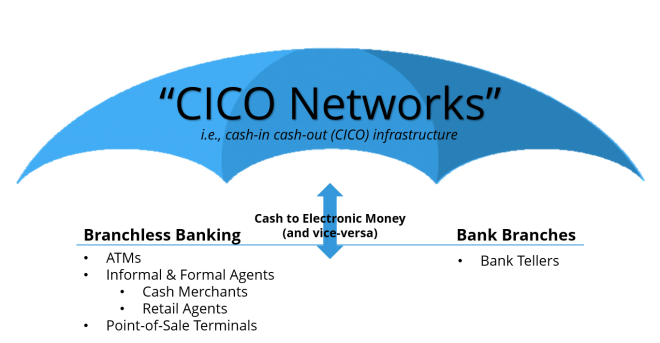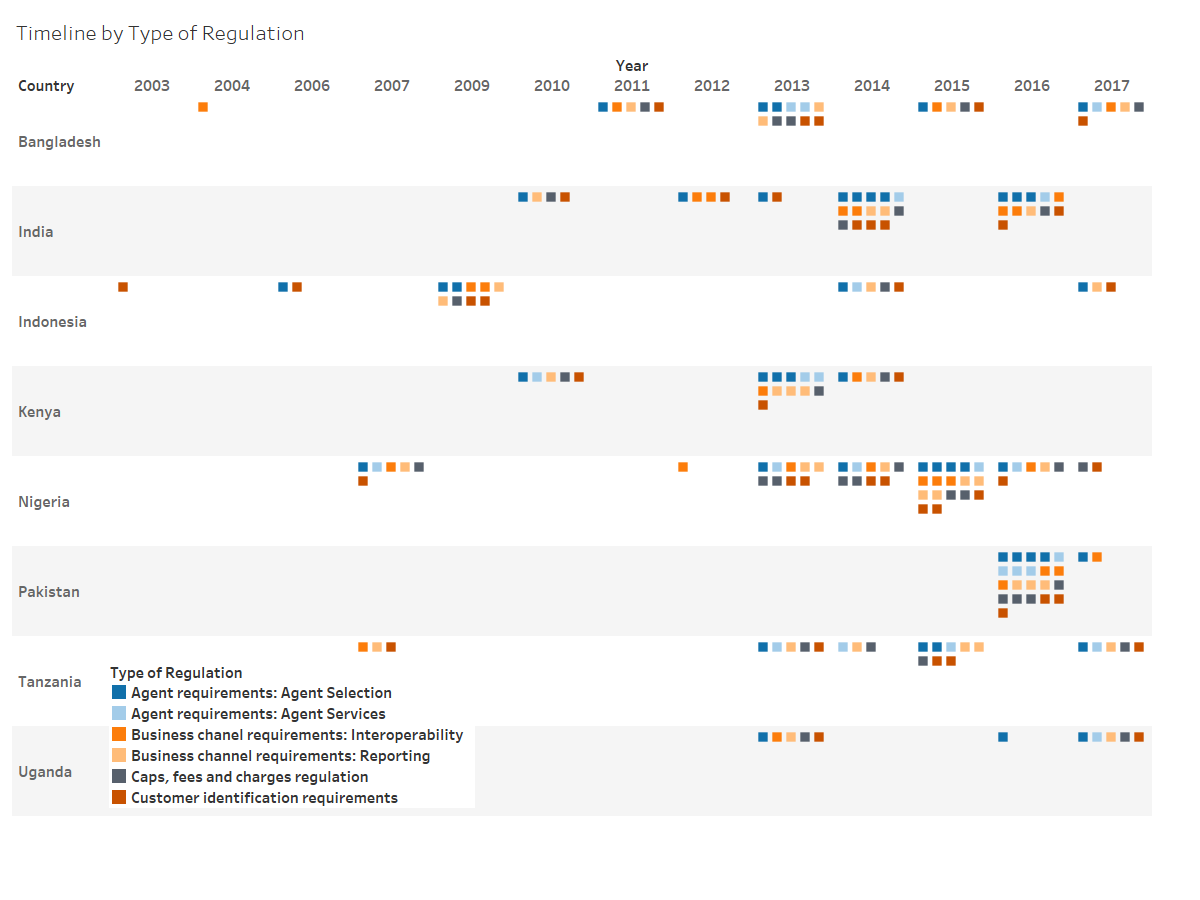Many individuals in low- and middle-income countries (LMICs) face a financial infrastructure gap, evidenced by very low numbers of bank branches and automated teller machines (ATMs). There are 2.9 bank branches and 0.5 ATMs per 100,000 people in Ethiopia, compared to 13.5 bank branches and 19.7 ATMs per 100,000 people in India, and 32.9 branches and 173 ATMs per 100,000 people in the United States.
One way organizations have begun addressing this financial infrastructure gap in low-income and rural communities is through the provision of digital financial services (DFS). DFS includes a broad range of financial services accessed and delivered through digital channels, including payments, credit, savings, remittances, and insurances. To utilize DFS however, users must be able to convert physical cash into electronic money through cash-in, cash-out (CICO) networks.
What are cash-in cash-out (CICO) networks?
CICO networks are the mechanisms through which customers can exchange cash for electronic value (sometimes called e-money) or vice versa. Physical access points—including both bank branches and “branchless banking" access points like ATMs, point-of-sale (POS) terminals, agents, and cash merchants—allow people to exchange cash and e-money. In many ways, these networks provide the infrastructure for communities often left out of formal financial services to access products and services.
Figure 1. The CICO Network Umbrella

What are the various types of CICO regulations?
As mobile money and branchless banking expand, countries are developing new regulations to govern their CICO operations. EPAR conducted a review of regulations in eight countries: Bangladesh, India, Indonesia, Kenya, Nigeria, Pakistan, Tanzania and Uganda. Our review identified six primary types of regulation:
- Agent selection: Regulations that determine whether bank and non-bank institutions may employ agents to provide branchless banking CICO services, and setting minimal requirements to become a CICO agent (e.g., agent has had an established commercial activity for the past two years)
- Agent services: The designation of classes between agents (e.g., master-agents, sub-agents) and what services each class may provide (e.g., whether they can provide services for more than one bank, whether they provide loans)
- Caps, fees, and charges: Limits on account or transaction sizes and on the fees that CICO providers may charge to customers (e.g., agent cannot charge fees beyond the financial institution’s prescribed fees)
- Customer identification: Procedures for identifying and verifying the identity of clients; also referred to as “Know-Your-Customer” or KYC regulations (e.g., identification documents required to open an account)
- Interoperability: Regulations promoting or limiting consumers’ ability to make payments or transfers across mobile money platforms and agents
- Reporting: Regulations around what information must be reported regarding agent and CICO locations, agent characteristics (e.g., gender, rural vs. urban) and the processes for consumers to authenticate agents (e.g., agent has logo of their financial institution displayed conspicuously)
How have CICO regulations developed over the last 15 years?
After identifying the major categories of CICO regulations, we looked for patterns and trends in the eight countries.
Figure 2. Timeline of CICO Regulations by Country and Regulation Type

Note: A given regulatory document may address multiple types of regulations (e.g., In Bangladesh, one regulation in 2011, Guidelines on Mobile Financial Services (MFS) for the Banks, included regulations of five types: (1) agent selection; (2) interoperability; (3) reporting; (4) caps, fees, and charges, and; (5) customer identification requirements. An interactive version of this timeline, including descriptions of each regulation, is available here.
Types of regulations that are relatively more common in early stages of CICO network development include agent selection, caps and fees, reporting requirements around agent and CICO locations, and customer identification requirements. On the other hand, regulations around agent services and reporting requirements about agent characteristics and the processes for consumers to authenticate agents tend to arrive later on.
We also observed regional differences in regulations. For example, among the South Asian countries in our study, customer identification requirements have transitioned from universal requirements (similar to traditional banks) to customized requirements (with ID requirements varying by the type of account or applicant). For instance, in Bangladesh a 2013 regulation simplified KYC requirements for mobile accounts exclusively engaging in low-value transactions, thereby making them more accessible to low-income consumers.
In comparison, the African countries in our study (with the exception of Nigeria) do not customize customer identification requirements by the level of the account. For example, in Kenya, payment service providers require identity card or passport numbers from all customers to open any type of account.
Some agent service regulations also differ regionally. The four African countries explicitly disallow agent exclusivity, meaning that financial service providers cannot prohibit their CICO agents from also working for other service providers. In contrast, the four South Asian countries either mandate, partially mandate, or allow agent exclusivity. These differences in regulations on agents’ ability to work for multiple financial institutions may affect the uptake and rate of growth of CICO networks in Africa and South Asia.
Interested in learning more about CICO networks?
EPAR has several publications on CICO network regulations in LMICs, including a full technical report summarizing the types of mobile money and branchless banking regulations related to CICO networks, and available evidence on the impacts these regulations may be having on markets and consumers (EPAR 355).
This post gives an overview of an addendum (EPAR 355a) to the full technical report. Another addendum (EPAR 355b) summarizes trends in exclusivity regulations. A final addendum (EPAR 355c) explores trends in CICO network expansion with a focus on policies seeking to improve access among more remote or under-served populations.
This research has also been published on Gates Open Research, where it is available for peer review.
By Melissa Howlett and Namrata Kolla
Summarizing original EPAR research by C. Leigh Anderson, Travis Reynolds, Marieka Klawitter, Pierre Biscaye, Kirby Callaway, Melissa Howlett, Namrata Kolla, Chelsea Sweeney & Emma Weaver